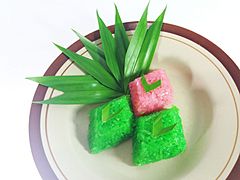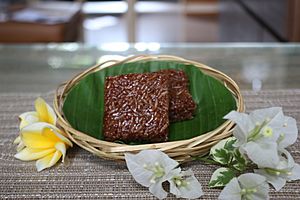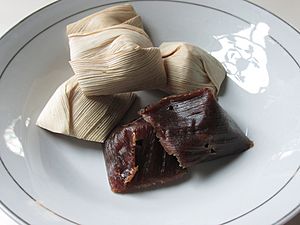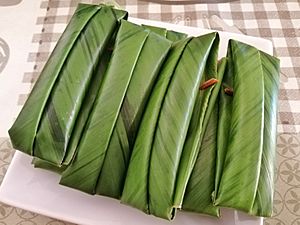Wajik facts for kids

Indonesian rhombus-shaped wajik
|
|
| Alternative names | Wajid, pulut manis |
|---|---|
| Type | Kue, kuih |
| Course | Snack |
| Place of origin | Indonesia. |
| Region or state | Java |
| Associated national cuisine | Brunei, Indonesia, Malaysia, Singapore |
| Serving temperature | Room temperature |
| Main ingredients | Glutinous rice, sugar, coconut milk |
Wajik or wajid is a yummy traditional sweet treat. It's also called pulut manis. This snack is made from rice, sugar, and coconut milk. It's a type of kue from Indonesia. It's also a kuih in Brunei, Singapore, and Malaysia, especially in Sabah.
Contents
What is Wajik?
Wajik is a sweet snack that looks like a diamond or a parallelogram. It's made by mixing sticky rice, sugar, and coconut milk. The official Indonesian dictionary describes it as a sweet food cut into these special shapes.
Wajik's Main Ingredients and Shapes
The main things used to make wajik are glutinous rice, palm sugar, and coconut milk. The high amount of sugar helps keep wajik fresh for a long time. It acts like a natural way to stop tiny germs from growing. If made and packed well, wajik can stay good for up to two weeks!
To make wajik smell even better, people often add nice-smelling ingredients. These can include pandanus leaves, vanilla, or even durian. There's also a type called wajik kelapa, which uses coconut and palm sugar.
Wajik comes in many different shapes. The most common shapes are the diamond or parallelogram. In Indonesia, you can find wajik in squares, rectangles, cylinders, and round shapes too. Sometimes, it's served as is. Other times, it's wrapped in banana leaves or dried corn husks.
Where Did Wajik Come From?
Wajik is thought to have started in Java, Indonesia. Sweet treats made with sticky rice and palm sugar have been popular in Java for a very long time. One of the first times wajik was mentioned was in an old Javanese book. This book, called Nawaruci, was written during the Majapahit period.
Over time, wajik became important in Javanese traditions. For example, there's a special ceremony called Numplak Wajik. This ceremony is held by the Keraton Yogyakarta (the royal palace) as part of the Grebeg Muludan festival, which is part of the Sekaten celebration.
Different Kinds of Wajik
Wajik in Brunei
In Brunei, this sweet treat is known as wajid. To make it, rice is steamed first. Then, it's mixed with coconut milk and caramelized sugar. Finally, it's wrapped in nyirik leaves. It's held together with a pin made from the middle part of oil palm leaves. This is similar to how kelupis is wrapped. It's seen as a traditional food that has been passed down through families for many years.
The usual kind of wajid is made with glutinous rice. The most popular type is wajid Jawa. This one uses a special fine-grained rice. Some local makers are trying new flavors. They add things like durian, pumpkin, yam, cassava, and chempedak.
Wajid, especially wajid Jawa, is a special food from the Temburong District. Because of this, it's also called wajid Temburong.
Wajik in Indonesia

You can find wajik in many different parts of Indonesia. It's popular in Javanese, Balinese, Sundanese, and Sumatran Malay cooking. In most parts of Indonesia, especially Java, it's called wajik. But in Sumatra, it's known as pulut manis, which means "sweet sticky rice."
It's made with steamed glutinous rice. This rice is then cooked more in palm sugar, coconut milk, and pandan leaves. After cooking, the rice is spread out and flattened. Once it cools down, it's cut into small pieces. These pieces are often shaped like a diamond or rhombus.
In the Indonesian language, the word wajik is used to describe a diamond or rhombus shape. So, in a card game, the "diamonds" suit is called wajik.
Wajik is very important in Javanese culture. It's often a key part of a Javanese selamatan ceremony. This is a special gathering. During the yearly Sekaten festival, there's a Tumplak wajik ceremony. Also, in the Pekalongan Regency, there's a special local wajik called Wajik Klethik.



